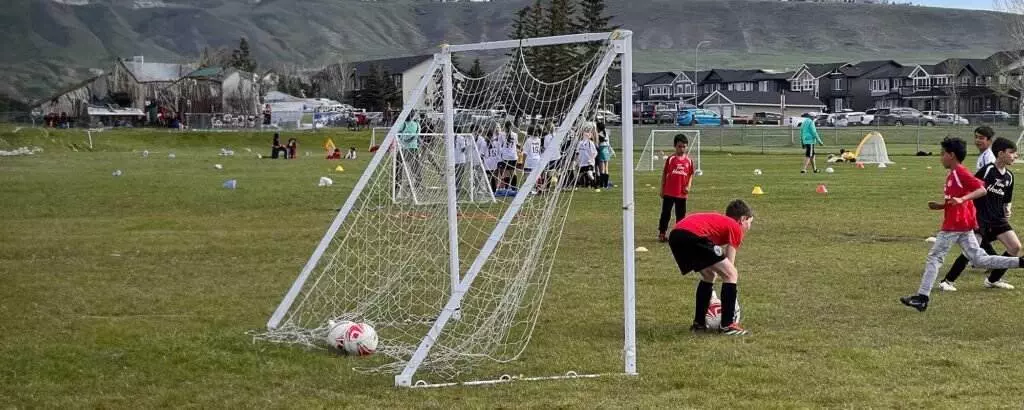At Cochrane Wolves FC, we believe in providing our players with top-notch facilities that meet all the standard requirements for various formats of the game. One of the most critical components of a soccer field is the goal. Whether for 11-a-side matches or smaller-sided games like 7v7 and 5v5, understanding the dimensions, materials, and maintenance of soccer goals is crucial for ensuring a quality playing experience. Let’s explore these aspects in detail.
Standard Dimensions for Soccer Goals
11-a-Side Goals
For full-size 11-a-side matches, the standard dimensions for the goal are:
- Width: 24 feet (7.32 meters)
- Height: 8 feet (2.44 meters)
These dimensions are consistent across all levels of play, from youth leagues to professional matches, ensuring uniformity and fairness. The size of these goals allows for a challenging but achievable target for players, making scoring an exciting part of the game.
7v7 Goals
For 7v7 games, which are common in youth soccer and development programs, the goals are smaller:
- Width: 12 feet (3.66 meters)
- Height: 6 feet (1.83 meters)
These reduced dimensions make the game more suitable for younger players, providing an appropriate challenge level and helping them develop their skills in a more manageable setting.
5v5 Goals
In 5v5 soccer, often played in training sessions or mini-leagues, the goals are even smaller:
- Width: 12 feet (3.66 meters)
- Height: 6 feet (1.83 meters)
These dimensions are the same as for 7v7, reflecting the smaller field size and fewer players, ensuring the game remains fast-paced and engaging.
Materials Used in Soccer Goals
Goal Posts and Crossbars
The materials used for goal posts and crossbars are designed to withstand the rigors of the game while ensuring safety and durability. Common materials include:
- Aluminum: Lightweight yet strong, aluminum is a popular choice for portable goals. It is resistant to rust and corrosion, making it ideal for outdoor use.
- Steel: Known for its sturdiness and durability, steel is often used for permanent or semi-permanent goals. It can handle high impacts but is heavier and requires more maintenance to prevent rust.
- Plastic or PVC: Used mainly for youth and training goals, plastic or PVC goals are lightweight and safe for younger players. They are easy to move and set up but less durable than metal options.
Goal Nets
The netting for soccer goals is equally important, as it must be strong enough to catch powerful shots without tearing. Common materials for nets include:
- Polyethylene: This synthetic material is durable, resistant to UV rays and weather conditions, making it a popular choice for outdoor goals.
- Nylon: Known for its strength and flexibility, nylon nets are used for both indoor and outdoor goals. They provide excellent durability and can withstand repeated impacts.
- Polypropylene: Lightweight and durable, polypropylene nets are also resistant to weather and UV rays, ensuring longevity.
Maintenance and Replacement of Soccer Goals
Regular Inspection and Maintenance
To ensure the safety and functionality of soccer goals, regular inspection and maintenance are crucial. At Cochrane Wolves FC, we adhere to a strict maintenance schedule that includes:
- Weekly Inspections: Checking the goalposts and nets for any signs of damage, wear, or instability. Ensuring that all bolts and connections are secure.
- Cleaning: Regular cleaning of goalposts to remove dirt, grime, and any potential rust spots, especially for steel goals.
- Net Checks: Inspecting the nets for tears or fraying. Replacing or repairing damaged sections to maintain safety and performance.
Replacement Frequency
The frequency of replacing soccer goals and nets depends on various factors, including usage intensity, weather conditions, and material quality. Here are some general guidelines:
- Goal Posts: High-quality aluminum or steel goal posts can last several years with proper maintenance. However, any signs of structural damage should prompt immediate replacement.
- Nets: Nets typically need replacing more frequently than posts. Depending on the material and usage, nets may need to be replaced every 1-3 years. Regular inspection helps identify wear and tear early, ensuring timely replacement.
Conclusion: Commitment to Quality at Cochrane Wolves FC
At Cochrane Wolves FC, we understand that the quality of our soccer goals directly impacts the safety and enjoyment of the game. By adhering to standard dimensions, using high-quality materials, and committing to regular maintenance, we provide our players with the best possible playing environment.
We invite parents and guardians to appreciate the care and attention that goes into maintaining our facilities. Ensuring our goals are up to standard is just one part of our broader commitment to excellence in youth soccer. Whether it’s through rigorous training, state-of-the-art equipment, or fostering a supportive community, Cochrane Wolves FC is dedicated to nurturing the next generation of soccer stars.
Thank you for being a part of our journey. Let’s continue to support our young athletes as they kick towards their dreams, one goal at a time!





